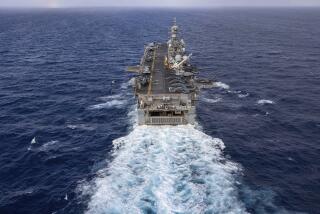Ferrying Military Operations Into Future
- Share via
HOBART, Australia — As a small-time ferryboat operator, Bob Clifford got his big break two decades ago when the only bridge over the river dividing his hometown collapsed after being hit by a freight ship, spurring demand for his service.
Now he’s talking with high-level U.S. defense officials about how they could use the giant, high-speed mass-transport ferries he helped pioneer to carry soldiers, tanks and helicopter gun ships into the 21st century’s military hot spots.
Clifford’s International Catamarans Pty. Ltd. is one of three Australian companies leading the world in developing technology that is quietly transforming the way people and cargo are moved on the high seas.
Incat’s ferryboats are unmistakable. Unlike conventional steel, mono-hulled boats, they are catamarans, with sharply pointed hulls known as “wave-piercing” because they cut through waves, rather than float over them.
Crafted of lightweight welded aluminum, the ships can travel as fast as 50 knots (50 mph)--some three times faster than conventional ships--without the stomach-churning pitch, roll and heave normally associated with sea travel.
With similar designs by Australian competitors Austal Ships Pty. Ltd. and Wavemaster International Pty. Ltd., the ships are revolutionizing the market for ferries designed for short trips with quick loading and unloading of cars and passengers. Incat alone claims 40% of the world market in high-speed ferryboats.
Australian ships currently ply waters in northern Europe, the Mediterranean, South America and Asia. The biggest of Incat’s current boats can carry 900 people and 240 cars, driven aboard in the same way as into a parking lot.
The ship makers have their eyes on other prizes.
“The freight market and the military market show a lot of potential,” said Clifford, a former fisherman and high school dropout.
In October 1997, U.S. Transportation Command called the world’s leading fast ship manufacturers to Washington for a workshop jointly sponsored by the U.S. Navy and Army.
The defense forces have identified more rapid deployment as one of the challenges for the next century.
Workshop delegates were told the Gulf War highlighted a problem for the Army: Soldiers are easier to move into a war zone than heavy machinery. That means hardware such as vehicles can still be on the wharves when troops are already fighting on the ground.
High-speed ferries may be a solution. The Pentagon has allocated $20 million to examine the technology, an Australian delegate to the workshop said.
What the Army would need is a fleet of as many as 60 ships that could carry between 2,000 and 10,000 metric tons at speeds up to 100 knots for up to 10,000 nautical miles.
“If they ask for it, we could deliver a prototype inside two years,” at a cost of about $100 million, Clifford said.
Clifford will demonstrate his $30-million, 300-foot “Devil Cat” to defense officials off the East Coast of the United States as it is delivered to its Canadian buyer this month.
Austal Chairman John Rothwell is “less bullish than Bob,” and said the U.S. talks were “first-round stuff.”
He said the Pentagon is more likely to adopt Australian-developed technology than buy its ships, although there is potential for joint ventures.
Freight is his target, particular in Asia. He said fast ships can compete with air freight on trips of less than 600 nautical miles, delivering perishables and expensive goods at one-third the cost.
“The world is moving into the next gear. . . . Once fast ferry freight starts, it is going to snowball the same way the car ferries have,” Rothwell said.
For the past 20 years--since the 1975 accident in which the 11,000-ton freighter Lake Illawarra collided with the Tasman Bridge in Hobart, sinking the ship, killing 12 people and sending demand for cross-Derwent River transport skyrocketing--Clifford has been refining his catamaran design. In the process he has tripled his business revenue in the past five years to $77 million.
In 1990, Incat’s Hoverspeed Great Britain shaved almost three hours off the record for a transatlantic crossing by a passenger ship. The ship won the Hales Trophy by covering 2,928 miles between New York and London in three days, seven hours and 54 minutes.
“I believe these types of ships are the way of the future and the rest of the world is slowly coming to that realization,” Clifford said.
More to Read
Sign up for Essential California
The most important California stories and recommendations in your inbox every morning.
You may occasionally receive promotional content from the Los Angeles Times.













